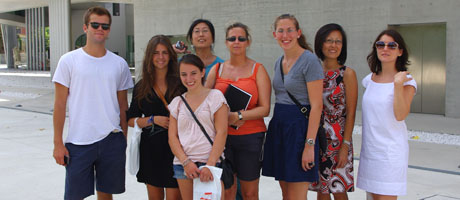Earlier this month, six GW students examined in-depth some of the world’s most famous architectural landmarks--researching, studying and sketching dozens of sites that span more than two millennia.
The interior design students enrolled in the Historical Influences on Design and Architecture class spent two weeks in Rome, where they focused on a different building each day—from the Colosseum and Pantheon to St. Peter’s Basilica and the modern Parco della Musica.
“We really wanted the students to experience these wonderful places with their own eyes,” says Catherine Anderson, assistant professor of interior design, who co-led the class along with colleague Nadia Volchansky-Nieves.
“Looking at photos of the Pantheon and reading that the dome is a perfect hemisphere is not enough to understand how the space actually feels,” says Ms. Volchansky-Nieves. “The study of architecture and interior design demands your presence.”
Before heading to Italy, the students studied Roman history and architecture for two weeks at GW.
In Rome, they built on their classroom knowledge, beginning each morning with a walk to the site of the day and related lecture. After the lectures, the class (professors included) spent an hour and a half sketching. Afternoons were spent exploring the city, while evening activities included concerts, visiting monuments or just people watching.
And as part of their assignment, the students completed a scavenger hunt that included 10 tasks, including finding the largest of the three surviving triumphal arches in Rome and sampling two different kinds of gelato.
Ms. Volchansky-Nieves says Rome is one of the best places in the world to study architecture and design.
“The Romans were the ‘master builders,’” she says. “We take for granted things like concrete, roads, aqueducts, arches and bridges. The Romans did not necessarily invent them all, but they were able to understand the utility of each and maximize their roles in the construction of civic buildings and structures.”
Emily Davis, a junior from Atlanta majoring in interior design who was part of the class, says she experienced the power and drama of both ancient and modern structures.
“I realized that my reactions to the excellence of the modern spaces, including the MAXXI (the Museum of Art and Architecture of the 21st Century) and the Auditorium Parco della Musica, were the same ones that I had when we visited the Colosseum and Pantheon,” she says.
“No matter how many years separate us and the ancient Romans, the fundamentals never changed,” says Ms. Davis, who hopes to pursue a career in health care facility design. “Grandeur is timeless in the world of architecture.”
And there’s no better way to experience the world of architecture than firsthand, says Ms. Anderson.
“You immediately understand the concept of scale, the design intent of the master minds behind these structures and you can appreciate the monumentality of these places,” she says. “You can easily forget this stuff when you see it on a PowerPoint presentation, but once you visit these locations, they’re indelibly etched in your mind.”


